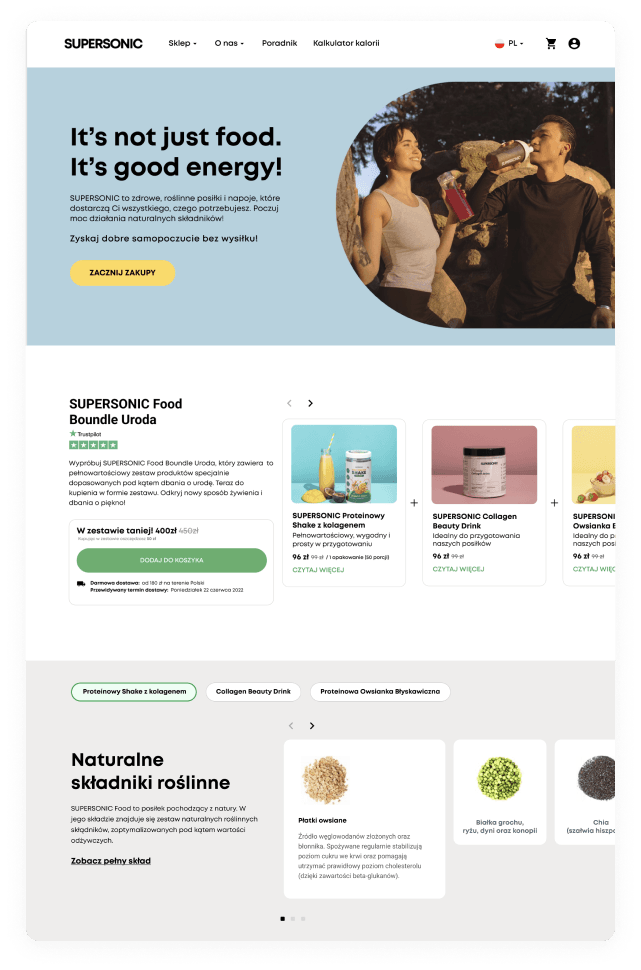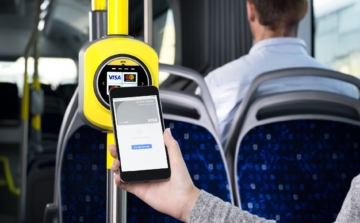

UX design – developing user experiences
Our iterative design process involves sketching, prototyping, and validation. A well-executed UX design phase allows for the development of a seamless and user-centered digital experience, which translates into improved conversion rates and better business outcomes.

What is UX design?
UX design is the process of designing and creating interactions between a user and a product service. The goal of UX design is to provide a positive and satisfying user experience while using a particular product or service. The UX design phase allows for a focus on the logic of the digital product without getting distracted by visual aspects. It is a very inspiring and invigorating step for the entire team involved in product creation, bringing a lot of learning and business reflection.
Increasing user satisfaction through intuitive and easy-to-use interfaces
UX design contributes to a positive user experience, which in turn can lead to greater loyalty, satisfaction, and repeat usage of a product or service.
Improving conversion rates and user engagement metrics
The result of UX design is an increase in the effectiveness marketing activities and improvement business outcomes.
Optimizing information structure and navigation
Proper content organization and-friendly navigation assist users accomplishing tasks on our website.
Reducing interface errors and user frustration
Fewer errors mean an improvement in user experience, which translates into, among other things, lower customer support costs.
Cost savings through reduced technical debt
Improving performance, stability, and scalability, thereby increasing business competitiveness.

Supersonic Food – Food of the Future. Health food store.

Our cooperation with SUPERSONIC Food began with store optimization, and after a few months it turned into full maintenance of the e-commerce website. Thanks to our cooperation with SUPERSONIC Food, we managed to achieve results that resulted in increased sales and improved website use (User Experience).
I recommend cooperation with Codeq to everyone looking for a dedicated e-commerce partner. Their holistic approach to e-commerce development, maintenance and security was crucial to the success of our online store.
Chris Kozak Founder @ SuperSonic FoodUI and UX design – differences
UI (User Interface) design and UX (User Experience) design are two distinct disciplines within the field of digital design.
UI design focuses on the visual and interactive elements of a digital product. It involves creating the aesthetic appearance of the product, including the layout, typography, colors, and overall visual style. UI designers are responsible for designing the buttons, menus, forms, and other interactive elements that users interact with. The goal of UI design is to create an attractive and user-friendly interface that is visually appealing and easy to navigate.
On the other hand, UX design is concerned with the overall experience that a user has while interacting with a digital product. It involves understanding the user’s needs, goals, and behaviors and designing the product in a way that meets those needs effectively and efficiently. UX designers conduct user research, create user personas, and develop user flows and wireframes to map out the user’s journey through the product. The goal of UX design is to create a seamless and enjoyable user experience that is intuitive and valuable to the user.
In summary, UI design focuses on the visual and interactive elements of a product, while UX design focuses on the overall user experience. Both disciplines are essential for creating successful digital products, as a visually appealing interface must also be user-friendly and provide a positive user experience.
Role of UX design in the digital world
The role of UX (User Experience) design in the world is crucial for creating successful and user-friendly digital products and services. UX design focuses on enhancing the overall experience that users have when interacting with a digital product or service, such as a website or mobile app.
UX designers work to understand the needs, goals, and behaviors of the target users. They conduct research, gather user feedback, and analyze data to gain insights into user preferences and pain points. This information is used to inform the design process and create intuitive and engaging user interfaces.
One of the primary goals of UX design is to ensure that the digital product or service is easy to use and navigate. This involves designing clear and logical user flows, organizing content in a way that is easy to understand, and providing intuitive navigation menus and controls.
UX designers also focus on creating visually appealing and aesthetically pleasing designs. They consider factors such as color schemes, typography, and visual hierarchy to create a visually cohesive and engaging user interface.
In addition to usability and aesthetics, UX design also takes into account the emotional aspect of user experience. UX designers aim to create positive emotional responses and build trust and satisfaction with the digital product or service. This can be achieved through thoughtful interactions, microinteractions, and the use of appropriate visual and audio cues.
Overall, the role of UX design in the digital world is to create user-centered and enjoyable experiences that meet the needs and expectations of the target users. By considering usability, aesthetics, and emotional factors, UX designers play a crucial role in shaping the success of digital products and services.
How to take care of user experience?
Taking care of user experience involves considering the needs, preferences, and expectations of users throughout the design and development process. Here are some key steps to ensure a positive user experience:
- User Research: Conduct research to understand the target users, their goals, behaviors, and pain points. This can involve surveys, interviews, and usability testing to gather insights and inform the design process.
- User-Centered Design: Design with the user in mind. Create user personas to represent different types of users and design interfaces that cater to their specific needs. Use techniques like user flows and wireframes to plan the user journey and ensure a seamless experience.
- Usability Testing: Test the usability of your design with real users. Observe how they interact with the product and gather feedback to identify any usability issues or areas for improvement. Iterate and refine the design based on the test results.
- Clear and Intuitive Navigation: Design a navigation structure that is easy to understand and navigate. Use clear labels, logical grouping, and intuitive icons to guide users through the interface and help them find what they need quickly.
- Consistency: Maintain consistency in design elements such as colors, typography, and layout across different screens and interactions. Consistency helps users build familiarity and reduces cognitive load.
- Responsive Design: Ensure that your design is responsive and works well across different devices and screen sizes. Optimize the layout, font sizes, and interactions to provide a seamless experience on both desktop and mobile devices.
- Performance Optimization: Pay attention to the performance of your digital product. Slow loading times and laggy interactions can frustrate users. Optimize images, minimize code, and use caching techniques to improve performance.
- Accessibility: Make your design accessible to users with disabilities. Consider factors such as color contrast, keyboard navigation, and screen reader compatibility to ensure that all users can access and use your product.
- Continuous Improvement: User experience is an ongoing process. Collect user feedback, analyze data, and make iterative improvements based on user needs and changing trends.
Remember, taking care of user experience is an ongoing effort that requires empathy, research, and continuous refinement. By prioritizing the needs of your users and incorporating their feedback, you can create a positive and engaging user experience.
UX design benefits
UX design, or User Experience design, several benefits that contribute to the success of digital products and services. Here are some key advantages of UX design:
Improved Usability
UX design focuses on creating intuitive and user-friendly interfaces. By considering user needs and behaviors, UX designers ensure that the product is easy to use and navigate. This leads to improved usability and a more positive user experience.
Example: A well-designed e-commerce website with clear navigation, intuitive search functionality, and a streamlined checkout process makes it easy for users to find purchase products, resulting in higher conversion rates.
Increased User Satisfaction
UX design aims to create enjoyable and engaging experiences for users. By considering factors such as aesthetics, interactions, and emotional responses, UX designers can create interfaces that evoke positive emotions and build trust with users. This leads to increased user satisfaction and loyalty.
Example: A mobile banking app that provides a visually appealing and seamless experience, with easy-to-understand transaction history and quick access to account information, enhances user satisfaction and encourages users to continue using the app.
Higher Conversion Rates
A well-designed user experience can positively impact conversion rates. By optimizing the user journey, reducing friction points, and providing clear calls to action, UX design can guide users towards desired actions, such as making a purchase or signing up for a service.
Example: An e-learning platform that offers a user-friendly interface, personalized course recommendations, and a straightforward enrollment process can increase conversion rates by making it easy for users to sign up and start learning.
Competitive Advantage
In today’s digital landscape, user experience can be a key differentiator. A well-designed and user-friendly product can set a brand apart from its competitors. By prioritizing user needs and preferences, UX design can help businesses stand out and attract and retain customers.
Example: A travel booking website that offers a seamless and enjoyable user experience, with easy search filters, informative descriptions, and a secure booking process, can gain a competitive advantage over other similar platforms.
Cost Savings
Investing in UX design upfront can lead to cost savings in the long run. By identifying and addressing usability issues early in the design process, businesses can avoid costly redesigns or fixes later on. Additionally, a positive user experience can reduce customer support needs and increase customer satisfaction, which can lead to long-term cost savings.
Example: A software application that undergoes thorough user testing and iteration during the design phase can identify and fix usability issues before the product is launched, saving the company from expensive post-launch updates and customer support requests.
Overall, UX design benefits businesses by improving usability, increasing user satisfaction, boosting conversion rates, providing a competitive advantage, and potentially saving costs. By prioritizing user needs and creating enjoyable experiences, businesses can create products and services that resonate with their target audience.
User experience design – step by step
User experience design (UX design) is the process of user satisfaction by improving the usability, accessibility, and overall enjoyment of a product or service. It involves understanding the needs and goals of the users and designing a solution that meets those needs effectively.
Here is a step-by-step breakdown of the UX design process:
- Research: The first step is to gather information about the target users, their behaviors, preferences, and needs. This can be done through surveys, interviews, and observations.
- User Personas: Based on the research, user personas are created. These are fictional representations of the target users, including their demographics, goals, and pain points.
- User Journey Mapping: User journey mapping involves visualizing the user’s experience from start to finish. It helps identify touchpoints and areas where improvements can be made.
- Information Architecture: This step involves organizing and structuring the content and functionality of the product or service. It includes creating sitemaps and navigation systems to ensure easy access to information.
- Wireframing: Wireframes are low-fidelity visual representations of the product or service. They outline the layout and structure without focusing on visual design. Wireframes help define the overall structure and functionality.
- Prototyping: Prototypes are interactive representations of the product or service. They allow users to interact with the design and provide feedback. Prototyping helps identify usability issues and refine the design.
- Visual Design: Once the structure and functionality are defined, visual design elements are added. This includes choosing colors, typography, and visual elements that align with the brand and create an appealing user interface.
- Usability Testing: Usability testing involves observing users as they interact with the prototype or the actual product. It helps identify any usability issues and gather feedback for further improvements.
- Iteration: Based on the feedback received during usability testing, the design is refined and iterated upon. This process continues until the design meets the user’s needs and expectations.
- Implementation: Once the design is finalized, it is handed over to the development team for implementation. The UX designer works closely with the developers to ensure the design is implemented correctly.
- Evaluation: After the product or service is launched, it is important to evaluate its performance and gather user feedback. This helps identify areas for improvement and informs future design iterations.
By following these steps, UX designers can create products and services that are user-centered, intuitive, and enjoyable to use.
User experience designer for your business
A user experience designer (UX designer) is a professional who specializes in creating and improving the overall user experience of a product or service. They focus on understanding the needs and goals of the users and designing solutions that meet those needs effectively.
If you’re looking to hire a UX designer for your business, here are some key aspects to consider:
- Expertise: Look for a UX designer who has experience and expertise in your industry or a similar field. They should have a strong understanding of user behavior and be able to apply their knowledge to create intuitive and user-friendly designs.
- Research and Analysis: A good UX designer will conduct thorough research to understand your target audience, their preferences, and pain points. They will analyze the data to gain insights and inform their design decisions.
- User-Centered Design: A UX designer should prioritize the needs and goals of the users throughout the design process. They should create user personas, conduct user testing, and incorporate user feedback to ensure the final design meets user expectations.
- Collaboration: UX designers often work closely with other stakeholders, such as developers, product managers, and marketers. Look for a designer who can effectively collaborate with cross-functional teams and communicate their design decisions clearly.
- Prototyping and Testing: A UX designer should be skilled in creating prototypes and conducting usability testing. This allows them to gather feedback early in the design process and make necessary improvements before final implementation.
- Visual Design Skills: While UX design primarily focuses on the overall user experience, having a good sense of visual design is also important. Look for a designer who can create visually appealing interfaces that align with your brand identity.
- Continuous Learning: The field of UX design is constantly evolving, so it’s important to find a designer who is committed to continuous learning and staying updated with the latest design trends and technologies.
UX design – user experience services by Codeq
User Experience design (UX design) is the process of designing the interaction between a user and a product, such as a website, online store, or application. The goal of UX design is to provide users with a positive and satisfying experience while using the product.
UX design for websites
In the case of websites, UX design focuses on providing intuitive navigation, legible content, and ease of use for the site’s features. UX designers strive to understand the needs and goals of users in order to tailor the interface of the website to their expectations. It is also important to provide a consistent look and style for the website, so that users can easily navigate and find the information they need.
UX design for e-commerce
For e-commerce stores, UX design aims to increase conversion and sales by optimizing the purchasing process. UX designers seek to create an intuitive interface that makes it easy for users to find products, compare them, and make a purchase. It is also important to provide a secure and convenient payment process, as well as easy navigation throughout the store’s website.
UX design for apps
UX design for applications aims to provide users with an easy and satisfying experience while using the app’s features and capabilities. UX designers seek to understand the context of app usage and tailor the interface to the needs of users. It is also important to provide intuitive navigation, legible content, and ease of use for the app’s features.
UX design for digital products
UX design for digital products focuses on creating a seamless and enjoyable user experience by understanding user needs, designing intuitive interfaces, and optimizing interactions. It involves research, prototyping, and testing to ensure that the product meets user expectations and provides value.
All of these aspects of UX design aim to increase user satisfaction, improve their efficiency, and encourage them to return to the product.
Trust our workflow
Great information architecture and comfortable navigation help users achieve their goals on your website. Build a website with us.
Discovery
During the discovery phase, we collect all the necessary data that allows us to make informed decisions in the following stages of the project. It helps us co-create a clear roadmap and product backlog (not sure what you mean by backlog here, maybe replace this with strategy).
Design
The UX and design phase consist of visualizing a previously developed concept. We recreate the information architecture and actualise your business goals through UX. Finally, the digital product comes to life with a specific visual style that aligns with your brand identity.
Development
Using the right tools and tech stack, everything from discovery and design is transformed into the language of technology. Every solution is complemented by extensive testing from a wide range of devices.
Support
The implementation of a digital product is only the beginning of the adventure. We offer support with maintenance and further development and are continuously present for our clients. Equipped with analytical data, we can create hypotheses and conduct A / B tests.
They trusted us
I recommend cooperation with Codeq to everyone looking for a dedicated e-commerce partner. Their holistic approach to e-commerce development, maintenance and security was crucial to the success of our online store.
Tools we use at work
Benefits of collaborating with Codeq
A 12 month warranty
The quality of work is not only empty promises. The warranty will give you assurance that our solution will be free from defects.
An experienced and well-coordinated project team
We employ the best WordPress and Shopify Developers in Poland with many years of commercial experience. We provide the highest quality of code and ongoing communication.
Efficient communication and project management
The refined and tested project management process and the continuous care of the Project Manager guarantee uninterrupted access to the status of our projects.
Technological polyglots
There are many specialists of various technologies on board our team. Thanks to them we are able to be your eyes and ears in the constantly changing world of technology.
Let’s discuss your idea!
Free consultation with an expert – maximum focus on your idea
An analysis of challenges and issues in the field of UX Design and Development
Recommendations for best practices in UX Design and Development
A comprehensive implementation plan from start to finish











